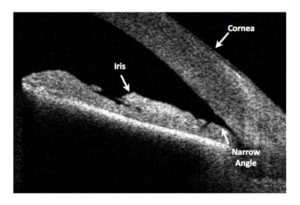JONATHAN S. MYERS, MD
Chief, Glaucoma Service
Angle closure glaucoma, also called narrow-angle glaucoma,
refers to intraocular eye pressure caused by inefficient
drainage of the eye canals.
It can present as acute glaucoma or chronic glaucoma
and requires immediate medical attention.
 Anatomically Narrow Angles
Anatomically Narrow Angles
When the anterior chamber angle is narrow, patients are at risk of developing both acute angle closure glaucoma and chronic angle closure glaucoma. However, it is important to understand that being at risk for glaucoma and having glaucoma are different. People with anatomically narrow angles carry only the predisposition to glaucoma without any evidence of glaucoma itself. Often, treatment of anatomically narrow angles may prevent the ultimate development of glaucoma. Laser therapy is one of the cornerstones of narrow angle treatment.
Acute Angle Closure Glaucoma
Acute angle closure glaucoma occurs when narrowing of the anterior chamber angle leads to a sudden increase in intraocular pressure. This is an ocular emergency. In acute angle closure glaucoma, the passageway to the eye’s drainage apparatus becomes so narrow that it disrupts flow of the fluid inside the eye to its drains. Rapid treatment to decrease the intraocular pressure and break the attack of angle closure is needed to preserve vision.
Chronic Angle Closure Glaucoma
The anterior chamber angle is composed of the iris and cornea. When the angle is narrow and these structures are very close together, scar tissue may form between them and overly the drainage apparatus of the eye. If enough of this scar tissue is present, elevated intaocular pressure and glaucoma develop over time in a process termed chronic angle closure glaucoma. Although in many people this condition is slowly progressive, acute (rapid) elevation of intraocular pressure may occur within the context of chronic angle closure glaucoma.
Angle Closure Glaucoma Symptoms
This rare form of glaucoma is very serious and can progress quickly, so if you are experiencing these symptoms please see a specialist immediately:
- Severe eye pain
- Headache
- Nausea and vomiting
- Blurred vision and/or seeing haloes around lights
- Incessant tearing
Request an Appointment TODAY
If you would like to speak with a Wills Eye representative for help finding a glaucoma physician
CALL 215-928-3197


JOEL S. SCHUMAN, MD
Co-Director

L. JAY KATZ, MD
Emeritus Director

ELIZABETH DALE, MD

JASON FLAMENDORF, MD

LAUREN E. HOCK, MD


NATASHA KOLOMEYER, MD

DANIEL LEE, MD

LINDSAY MACHEN, MD

MARLENE R. MOSTER, MD

MICHAEL PRO, MD


REZA RAZEGHINEJAD, MD

MARY JUDE COX, MD

RACHEL NIKNAM, MD

JESSE RICHMAN, MD

GEOFFREY SCHWARTZ, MD

COURTLAND SCHMIDT JR., MD

ALICE WILLIAMS, MD

Closed Angle Glaucoma Treatment
Treatment for closed-angle glaucoma includes laser treatments or surgery to unblock the canals and allow fluid to drain. Treatment is generally successful and depends on the severity and progression of the illness, as well as other unique patient factors.
- Peripheral iridotomy. This laser treatment for narrow angles creates a small hole in the iris (the colored part of the eye).This hole can decrease the risk of acute angle closure glaucoma. Additionally, the hole may result in widening of the narrow anterior chamber angle, depending on the patient.
- Medications
- Cataract surgery
- Glaucoma surgery
If you are experiencing the symptoms of narrow-angle glaucoma it is important that you seek assistance right away. Contact us at Wills Eye Hospital today to visit with a specialist.
